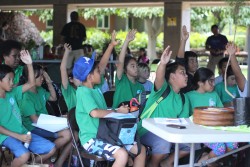Keiki Learn Conservation
Molokai youth don’t have to wait till they’re older to make a difference in the environment. At Keiki Earth Day last Thursday, elementary students from around the island learned how they can save energy, use natural resources and be on the lookout for invasive species.

A student sketches a canoe at the Hokule`a Earth Day station, where students learn how crew practice sustainability. Photos by Colleen Uechi.
“It’s important to know because plants and animals need to stay alive to help our native forests and to help our plants,” said Kilohana third grader Waimoku Pale.
This year’s Earth Day theme, Mai Ke Kupu Mole Hawaii, means “All is found in the Source.” Hokule`a crewmember Mahina Hou Ross said a similar theme applies while voyaging.
“When you’re on Hokule`a, the canoe is your land … You have all the food, the water, and you need to care for those resources because it’s limited,” said Ross. “… Then when you come back to land you realize your island is your canoe and you gotta use that same mentality.”
While last Friday’s main Earth Day event offered informational booths that residents could browse at their leisure, students at Keiki Earth Day rotated through stations participating in activities specifically geared toward connecting kids to caring for the land.
Earth Day presenters encouraged students to foster natural resources. Butch Haase, executive director of Molokai Land Trust, gave keiki seeds for ko`oko`lau, an endangered Hawaiian plant used to make tea.
Nurturing native species, especially those at risk, is crucial for the community, said Penny Martin, who works as an environmental educator with nonprofit Papahana Kuaola.
“If we can’t protect them, how can we realize their potential?” she asked, pointing out that many plants hold food and medicinal uses yet to be discovered.
Energy is also a vital resource, explained Maui Electric Communication Specialist Shayna Decker. She said families can conserve electricity by focusing on seemingly minor details, like deciding what to eat before opening the fridge instead of holding it open while mulling over meal choices.
“Little things like that all add up,” she said. “It’s just to remind people, because everyone forgets. … It’s a matter of just being aware and taking time to kinda think things through.”
With fruit-picking season approaching, Decker reminded students to watch for lines when climbing trees.
Maunaloa fourth grader Raven Morris left with a lesson firmly in mind.
“I learned that if you touch an electrical line you will get shocked, so always pay attention where you are,” she said.
Preserving the `aina also means fighting its threats, explained Estella Snowden, field associate for the Maui Invasive Species Committee (MISC). One of Hawaii’s biggest environmental problems, the red fire ant, is something they’re trying to keep off of Molokai, she said.
“Ecologically they’re a nightmare,” said Snowden. “Anywhere they live, all the other species leave. … They’re so small and it’s hard to detect them until they’re a problem.”
Snowden encouraged families to do a fire ant test by leaving out a peanut butter-coated stick for 45 minutes and sending any red ants to Molokai MISC offices for testing. She also recommended temporarily quarantining plants and building materials from off island.
“We have everything we need, but there’s stuff like that that threaten,” said Martin. “We learned about the red fire ants … so we can protect our resources.”












Don't have a Molokai Dispatch ID?
Sign up is easy. Sign up now
You must login to post a comment.
Lost Password